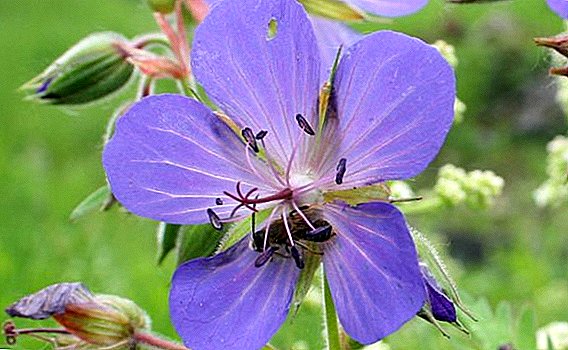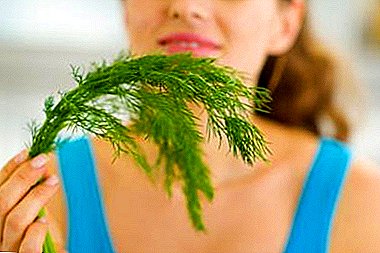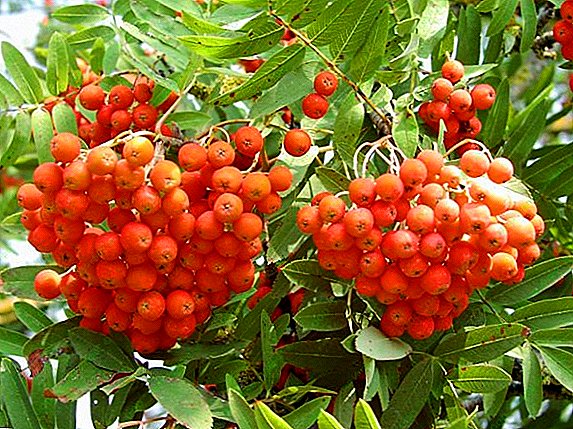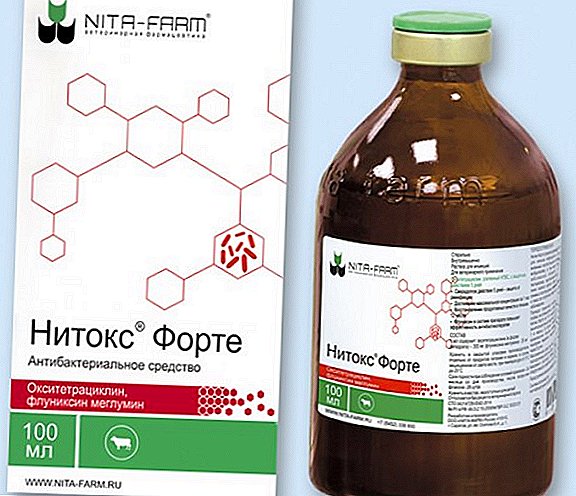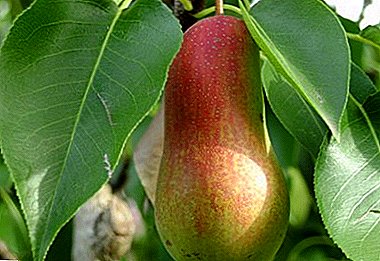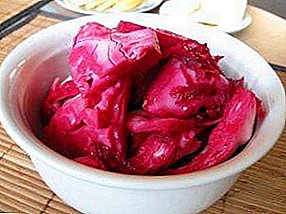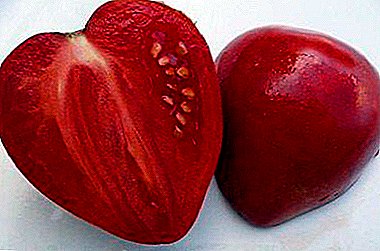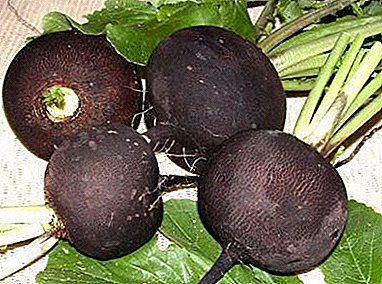
Radish is a genus of herbaceous plants of the Cabbage family. In the wild form is found in Europe and temperate latitudes of Asia.
The edible part of the radish is a root vegetable that tastes like radishes. The plant is highly valued in traditional medicine for its beneficial properties and is widely used in cooking for the preparation of salads, appetizers, soups and other dishes.
The article tells in detail about the features of growing radish and compatibility with other vegetables. Reveal the secrets of a good harvest. And also tell you about the possible difficulties and how to overcome them.
Features of growing and care
Growing radish has certain features, distinguishing care for her from care for other vegetables:
- Sensitivity to light - its deficiency will lead to the formation of unsuitable for consumption of root crops. It is best to grow in an open area with an excess of sunlight.
- The application of fresh organic fertilizers under the radish is not practiced: it will provoke the multiplication of pests, enhanced booting.
- For harvest in summer, radishes are planted in early May, for winter harvesting - in the second half of June.
- To grow high-quality root crops on dry and hard ground.
- The best soil for growing crops is loam. Unlike other vegetables, the soil like black soil will not work for radish.
- The radish is resistant to low temperatures on the soil and in the air, it endures sharp temperature fluctuations.
- This culture, unlike many others, in most cases does not require additional fertilizing.
- During periods of drought, abundant watering is obligatory in order to avoid cracking the fruit and the appearance of bitterness in them.
Compatible with other vegetables
Radish prefers the neighborhood of such crops as radishes, carrots, spinach, cucumbers, zucchini, tomatoes, beets and parsnips. From the idea of planting on the same bed with radish cabbage, peas or strawberries should be abandoned. Radish gives a good harvest, if before it on the site grew tomatoes, potatoes, greens, cucumbers or pumpkins.
Variety selection
 Among the variety of varieties of radish there are early ripening (for example, Mayskaya), mid-ripening (Margelanskaya, Chudnaya) and late-ripening (Doctor, Gaivoronskaya).
Among the variety of varieties of radish there are early ripening (for example, Mayskaya), mid-ripening (Margelanskaya, Chudnaya) and late-ripening (Doctor, Gaivoronskaya).
Variety selection will be based on factors such as the desired harvest time, climate and weather conditions of the area, in which the vegetable will be grown, taste and medicinal properties, the estimated shelf life, the amount of the crop, etc.
For early harvest, frost-resistant varieties that can be planted as early as March are preferred. If you want the harvest to retain its quality longer, such varieties as Winter Round White or Winter Long Black are suitable. When growing radish for medicinal purposes, the choice should be made in favor of the Margelanskaya variety.
One of the best is the variety Daikon. It has a pleasant taste, unpretentious, roots can reach sizes up to 60 cm in length and up to 10 cm in diameter. Edible are all parts of the plant.
Reference. This plant is distinguished by the fact that it does not absorb harmful substances from the environment, it can be safely planted in environmentally polluted areas - toxins in the root crop will not accumulate.
Radish varieties, the selection of which took place in Russia, are the least demanding of the conditions of care and are most adapted for cultivation in the northern and temperate latitudes.
Buying seeds
You can buy radish seeds in specialized stores or via the Internet. Sellers with a dubious reputation should not purchase planting material. Prices for seeds range from 5 to 3500 rubles. per package, depending on the type, quality of the goods, weight of the contents of the package, etc.
Growing Instructions
In the greenhouse
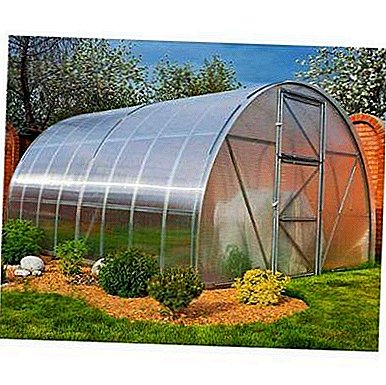 Landing. The radish in the greenhouse can be planted both in spring and summer, and at the beginning of winter. The soil before planting should be wet, it is recommended to make mineral fertilizers. Seeds are planted in the soil to a depth of 3 cm, the interval is 15 cm. The distance between the rows is at least 20 cm.
Landing. The radish in the greenhouse can be planted both in spring and summer, and at the beginning of winter. The soil before planting should be wet, it is recommended to make mineral fertilizers. Seeds are planted in the soil to a depth of 3 cm, the interval is 15 cm. The distance between the rows is at least 20 cm.- Growing conditions. In a greenhouse, a stable temperature (about 20-23 degrees) must be maintained. It is important to provide the vegetable with an additional light source (for example, fluorescent lamps).
- Watering. Greenhouse radish is watered as the soil dries, on average - once every 14-15 days, winter varieties less often. Watering should be abundant (about 8-10 liters of water per 1m2).
- Top dressing. Radish needs mineral fertilizers no more than 1-2 times during the whole growing period (at the sprout stage and one month later). Late-ripen autumn varieties fertilize weekly (in addition to mineral fertilizers, nitrogen fertilizers are used).
- Weeding. The weeds that grow near the radish should be regularly removed - manually (pulling out of the soil) or using special equipment (for example, choppers). 2-3 times a month is useful shallow soil loosening.
- Thinning. Radish - a large plant, for the full development of sprouts need to be thinned in a timely manner (after germination and 2-3 weeks after the first thinning). Weak sprouts should be cut at the base of the stem, rather than pulled from the root (this can damage the rhizomes of healthy plants).
- Hilling it is used only in the cold season (to prevent freezing).
In the open ground
Landing is carried out both in spring time and in summer. Sub-winter planting is allowed (when using seed of special varieties). There are 2 main landing methods:
Seedless
 Landing. Prepared seeds are planted in a pre-fertilized and moistened soil with marked grooves (to a depth of 2-3 cm), sprinkled with earth, tamped, and mulch the beds. The interval between seeds is 15-20 cm, between rows - 20-25 cm.
Landing. Prepared seeds are planted in a pre-fertilized and moistened soil with marked grooves (to a depth of 2-3 cm), sprinkled with earth, tamped, and mulch the beds. The interval between seeds is 15-20 cm, between rows - 20-25 cm.- Growing conditions. The optimal temperature for the growth of the root - 18-22 degrees. Radish for uniform ripening prefers a long day light.
- Watering should be regular. Long breaks can lead to the formation of cavities in the roots. At first, after germination, the radish is watered once every 10 days, in summer - as the soil dries out. At 1 m2 10-15 liters of water should go. Winter varieties do not require abundant watering.
- Top dressing. During the season, mineral fertilizers are applied 2 times - at the stage of appearance of 2-3 true leaves in sprouts and at the initial stage of the formation of the fruit, 25-30 days after the first feeding. Application of dressings is stopped 3 weeks before harvest.
- Weeding. Weeds are removed from the bed as they grow. Weeds increase the risk of garden pests, "pull" from the soil moisture and nutrients. After watering, it is recommended to loosen the soil (not deeper than 6-7 cm).
- Thinning produce some time after germination of seedlings. Extra and weakened sprouts are removed, pulling or cutting them. Between sprouts leave 5-6 cm of free soil. During re-thinning, the distance between them should increase to 15 cm (in the case of summer varieties) or to 20-25 cm (in the case of winter varieties).
- Hilling. It is made to prevent the rapid evaporation of moisture from the soil, to protect autumn-winter crops from frost. Still carried out as the upper part of the root becomes visible from the ground - in this case, the process of "scrubbing" the soil around the plant helps to preserve the taste of the product.
Rassadny
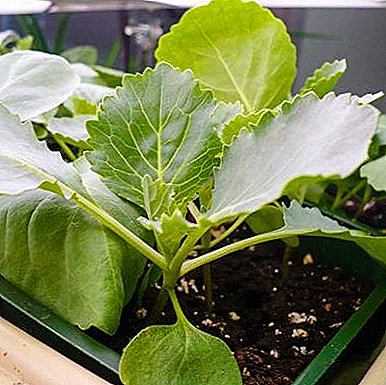 Landing. Sowing seeds is carried out in containers filled with nutrient substrate. The interval between seeds is at least 3 cm.
Landing. Sowing seeds is carried out in containers filled with nutrient substrate. The interval between seeds is at least 3 cm.- Growing conditions. Seedlings are kept in a dry dark place, after the appearance of sprouts transferred to the sunny side or balcony.
- Watering and feeding. Water sprouts depending on soil moisture, on average once every 10-12 days. During the growing of seedlings, top dressing is not introduced, rather fertilized soil is used when planting seeds.
- Thinning Radish at home is as necessary as when grown in a greenhouse or open ground from seeds.
- Weeding and hilling seedlings do not produce. In the phase of 3-4 leaves of this plant are planted in the garden.
At home
Spread full-scale cultivation on the balcony in large tanks.
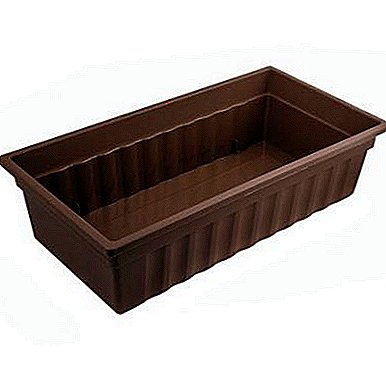 Planting in tubs is carried out so that the plants do not interfere with each other, and the roots have enough space for development. Early and unpretentious varieties are best suited.
Planting in tubs is carried out so that the plants do not interfere with each other, and the roots have enough space for development. Early and unpretentious varieties are best suited.- Conditions. The optimum temperature is 15-22 degrees. In winter, the plant can be transferred to the room, in the warm season - put in the open air.
- Watering is done once a week, feeding is made 1-2 times per season.
- Thinning - a mandatory event in the care of home radish.
- Weeding is carried out as needed.
- Hilling is done only if the roots are bare.
Secrets of a good harvest
When growing it is important to remember some subtleties:
- Mulching of beds will help the earth to retain moisture and useful substances longer, and a moisture-loving culture will delight you with a rich harvest.
- Indicators of soil acidity should be low, then the roots will be large, with a rich taste.
- The abundance of sunlight is the key to the development of large root crops.
- Pollination of the land with tobacco dust with ash every few days. This will protect the plant from pests, and the ash will act as a potash fertilizer.
Diseases
- White rot - defeat and discoloration of tissues.
- Mealy dew - affects the stalks and leaves, less often - the stems.
- Blackleg - fungal infection of the upper part of the root and the lower part of the leafy rosette.
Struggle: isolation of healthy plants from diseased, utilization of damaged parts or diseased plants, treatment with drugs that prevent the development of pathogenic flora.
Pests
- Kapustnitsa (butterfly).
- The cabbage moth.
- Spring cabbage fly.
- Cruciferous flea.
Fight: spraying the affected plants with water and insecticides, isolating them from other crops.
Prevention: timely and regular antiparasitic treatment.
Possible difficulties and ways to overcome them
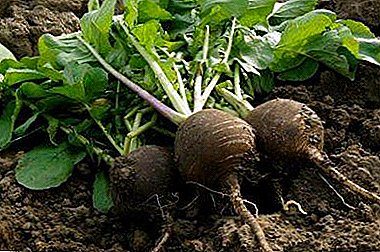 Root rotting. Occurs due to excess moisture. The amount of water needs to be reduced.
Root rotting. Occurs due to excess moisture. The amount of water needs to be reduced.- Fruits develop poorly. Perhaps the plant does not have enough light or the soil is too heavy. The problem is solved by transferring to more suitable conditions, regular loosening of the soil.
- Strong bolting. Perhaps the soil is strongly acidified. It is allowed by artificial decrease in soil acidity (for example, by liming).
- Cracking of the fetus. May be due to moisture deficiency. It is necessary to adjust the irrigation regime, to produce mulching of beds or hilling of plants.
To replenish the body with vitamins and nutrients, it is recommended to add radish to the usual diet in winter and springtime. Vegetable has established itself as an effective preventive and anti-inflammatory agent, due to which it is becoming more and more popular for cultivation in private plots.


 Landing. The radish in the greenhouse can be planted both in spring and summer, and at the beginning of winter. The soil before planting should be wet, it is recommended to make mineral fertilizers. Seeds are planted in the soil to a depth of 3 cm, the interval is 15 cm. The distance between the rows is at least 20 cm.
Landing. The radish in the greenhouse can be planted both in spring and summer, and at the beginning of winter. The soil before planting should be wet, it is recommended to make mineral fertilizers. Seeds are planted in the soil to a depth of 3 cm, the interval is 15 cm. The distance between the rows is at least 20 cm. Landing. Prepared seeds are planted in a pre-fertilized and moistened soil with marked grooves (to a depth of 2-3 cm), sprinkled with earth, tamped, and mulch the beds. The interval between seeds is 15-20 cm, between rows - 20-25 cm.
Landing. Prepared seeds are planted in a pre-fertilized and moistened soil with marked grooves (to a depth of 2-3 cm), sprinkled with earth, tamped, and mulch the beds. The interval between seeds is 15-20 cm, between rows - 20-25 cm. Landing. Sowing seeds is carried out in containers filled with nutrient substrate. The interval between seeds is at least 3 cm.
Landing. Sowing seeds is carried out in containers filled with nutrient substrate. The interval between seeds is at least 3 cm. Planting in tubs is carried out so that the plants do not interfere with each other, and the roots have enough space for development. Early and unpretentious varieties are best suited.
Planting in tubs is carried out so that the plants do not interfere with each other, and the roots have enough space for development. Early and unpretentious varieties are best suited. Root rotting. Occurs due to excess moisture. The amount of water needs to be reduced.
Root rotting. Occurs due to excess moisture. The amount of water needs to be reduced.